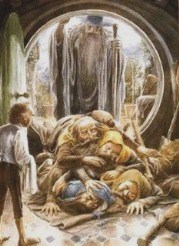The following event(s) took place in Middle-earth on June 22nd:
- Bilbo returns to the Shire with the Ring (1342)
- [Join us on the Discussion Boards here]
The following event(s) took place in Middle-earth on June 22nd: Bilbo returns to the Shire with the Ring (1342)…
Continue Reading The following event(s) took place in Middle-earth on June 22nd:
These are heady days for fans who enjoy seeing Tolkien’s legendarium interpreted by ‘other minds and hands’! A year ago we reported that the Tolkien Estate had granted permission for composer Paul Corfield Godfrey‘s musical chapters from The Lord of the Rings to be released. We are delighted to reveal today that the recording of these works will be released this September – and is available for pre-order now!
Featuring 35 singers, most of whom are from Welsh National Opera, these chapters (and, in true Tolkien styles, some appendices) make up over 17 hours of music, and use text lifted almost entirely verbatim from Tolkien’s masterpiece. Looking at the cast list, we’re excited to see both Tom Bombadil and his fair companion Goldberry listed! The recording will be available as a 15 CD Deluxe Digibook with 64 page complete libretto and notes from the composer.

Here’s the official press release from Volante Opera:
The agreement by the estate of the late J. R. R. Tolkien last year to sanction the recording of Paul Corfield Godfrey’s “musical chapters from The Lord of the Rings” was hailed by listeners throughout the world as a milestone in the field of Tolkien adaptations.
For many years the Tolkien Estate has refused to allow any musical treatment of the works of the author which employed his own words. Now they have agreed to make a concession in respect of the music of Paul Corfield Godfrey, whose acclaimed cycle of “epic scenes from The Silmarillion” was finally completed in 2023 with the issue of a ten-CD series of recordings from Volante Opera and Prima Facie Records.
Ever since the 1960s the composer had been working on sketches, fragments and episodes of what was originally envisaged as a cycle of musical works based upon The Lord of the Rings. Following on from the success of the recordings of The Silmarillion he was persuaded to go back to these beginnings and fully explore, expand and complete the work which has now evolved as “musical chapters from The Lord of the Rings”. This fully operatic setting has now become a companion work on the same scale as The Silmarillion. The adaptation extends to thirty “chapters” designed for performance over six evenings – more than fifteen hours of music.
Cast
This recording of the complete work by Volante Opera has now finally been completed and Prima Facie will release a demo set of the complete cycle, in the same manner as their Silmarillion recordings, in a single volume on 5 September 2025. The professional singers, some thirty-five in number, come mainly from Welsh National Opera. Returning artists from The Silmarillion include: Simon Crosby Buttle as Frodo, Julian Boyce as Sam, Philip Lloyd-Evans as Gandalf, Stephen Wells as Aragorn, Michael Clifton-Thompson as Gollum, Helen Jarmany as Éowyn, Huw Llywelyn as Bilbo and Éomer, Emma Mary Llewellyn as Arwen and Goldberry, Laurence Cole as Boromir and Denethor, Martin Lloyd as Treebeard and the Herb Master, Helen Greenaway as Lobelia and Ioreth, Rosie Hay as Gwaihir, Sophie Yelland as the Barrow-Wight and Louise Ratcliffe as Lindir, with George Newton-Fitzgerald and Jasey Hall taking on a plethora of parts. Angharad Morgan is also reprising her role as Galadriel from The War of Wrath. Other new cast members include Rhodri Prys Jones as Legolas, Gareth Long as Gimli, David Fortey as Pippin, Dyfed Wyn Evans as Merry, James Schouten as Faramir and Elrond, Gavin Davies as Thëoden, Gareth Lloyd as Saruman, Peter Wilman, Owen Webb, Alastair Moore, Francesca Saracino and Steffan Lloyd-Evans in various other solo roles and Howard Kirk as Tom Bombadil and Quickbeam.
Plot
Although the text is inevitably abridged, it adheres without any but the most minor alterations to the author’s original words, and the original plot development remains unchanged – including such elements as Tom Bombadil and the Barrow-wight, the love story of Éowyn and Faramir and the ‘scouring of the Shire’. And some other passages, such as the coronation and wedding of Aragorn, are given expanded musical treatment. The issue includes not only the complete musical score, but also a substantial booklet containing full details of the recording (including the text as set) and a supplementary appendix disc giving more extended versions of some of the more substantial narrative poems. As with the earlier issues of The Silmarillion the cover art has been furnished by Ted Nasmith.
Find out more about the recordings by Volante Opera Productions
Discover the Music of Paul Corfield Godfrey

Physical copies directly from Volante Opera Productions available for pre-order now; orders from other retailers will be closer to the release date.
Digital purchase will be available to pre-order seven days before release date of Sept 5th. Streaming platforms will be very limited but specific platforms will be itemised closer to the release.
And just to make September 5th seem even longer to wait – here’s a teaser trailer to whet your appetite! (You can see a longer trailer here.)
 The following event(s) took place in Middle-earth on May 1st:
The following event(s) took place in Middle-earth on May 1st:
 The following event(s) took place in Middle-earth on April 26th:
The following event(s) took place in Middle-earth on April 26th:
Back in the middle of March we began our annual tournament of Middle-earth March Madness: with this year’s theme being The Art of Middle-earth. Three weeks and thousands of votes later, the Grand Champion 2025 has been decided.

Alan Lee’s Edoras faced Turner Mohan‘s Lúthien and Morgoth; a very familiar scene from a well-known artist, and a First Age scene from a lesser-known artist. Both are stunning works, filled with shadows and light; but starkly contrasting. One is a landscape with no figures; the other shows two figures with no discernible landscape.


Their journeys to the final battle were also very different. The closest fight Edoras had to face was against Donato Giancola’s Walls of Moria, which claimed 45% of the vote. In the rest of the matchups, Alan Lee’s piece won by margins in the 70s and 80s percentage-wise. Mohan’s piece, on the other hand, only ever won by numbers in the 50s; in the second round, only ONE vote separated Lúthien and Morgoth from its competitor, Angelo Montanini‘s Radagast the Magician. A beautiful piece and a very worthy competitor, nonetheless Lúthien and Morgoth had to fight harder to make it to the final.
So it is perhaps not a surprise that this year’s Grand Champion of Middle-earth March Madness is:

It has been a steady, even overwhelming Ride of the Rohirrim finally bringing the gritty endurance of the Lúthien/Morgoth faceoff to the end of its exciting underdog run! The most serious competition that Edoras faced during the tournament came against Donato Giancola’s The Walls of Moria, a 55/45 matchup; even while Mohan’s Lúthien and Morgoth escaped from two of its matchups with a combined total of six votes. This has been by far the most competitive contest across the entire field that I can remember over many years of Middle-earth March Madness — a testament to the wide appeal and high quality of every artist featured. Here’s hoping that prints of some of their works have found new homes! I know they have in mine! Did you find a new piece to hang on your wall?
Special thanks to artists Jerry VanderStelt, Ted Nasmith and Donato Giancola, who took the time to chat with us on livestreams, and to tell us about their work and their love of Tolkien. (You can see those conversations on our YouTube channel.) And of course thanks to all of YOU, who joined the fun and voted! See you for more Middle-earth March Madness next year!

The following event(s) took place in Middle-earth on April 8th: